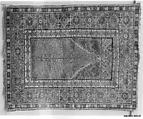Prayer Rug with Niche Design
Not on view
Prayer rugs or "seccade" carpets were among the most popular rugs woven in Anatolia. Common features are the characteristic niche design evoking the mihrab or prayer niche and the smaller size that makes such carpets suitable for individual use. Departing from classical Ottoman court carpets, distinct designs and styles were created over time in villages and smaller towns of Anatolia, explaining the existence of a variety of types. This example from Mücür in central Anatolia was woven upside down, a process in which the weaver first produced the more complicated part of the rug pattern such as the frieze atop the niche with facing arrows that alternate with stylized palmette-like motifs. Further characteristics are the regularity of the almost symmetrical design based on the repetition of geometrized medallion cartouches that derive from floral compositions that are repeated in the border. The choice to apply different tones for small units of motifs, renders this carpet colorful and vibrant, similar to a mosaic floor. The shape of the niche with a staggered arch recalling a stairway suggest the design of muqarnas prayer niches that were so popular in Seljuq and Ottoman mosques and other places for prayer. A slender tree of life woven in vivid green even though its foliage is sparse, clearly stands out from the deep red ground. The gate of paradise and symbols of immortality can be associated with the design of this rug.
Due to rights restrictions, this image cannot be enlarged, viewed at full screen, or downloaded.
This artwork is meant to be viewed from right to left. Scroll left to view more.



